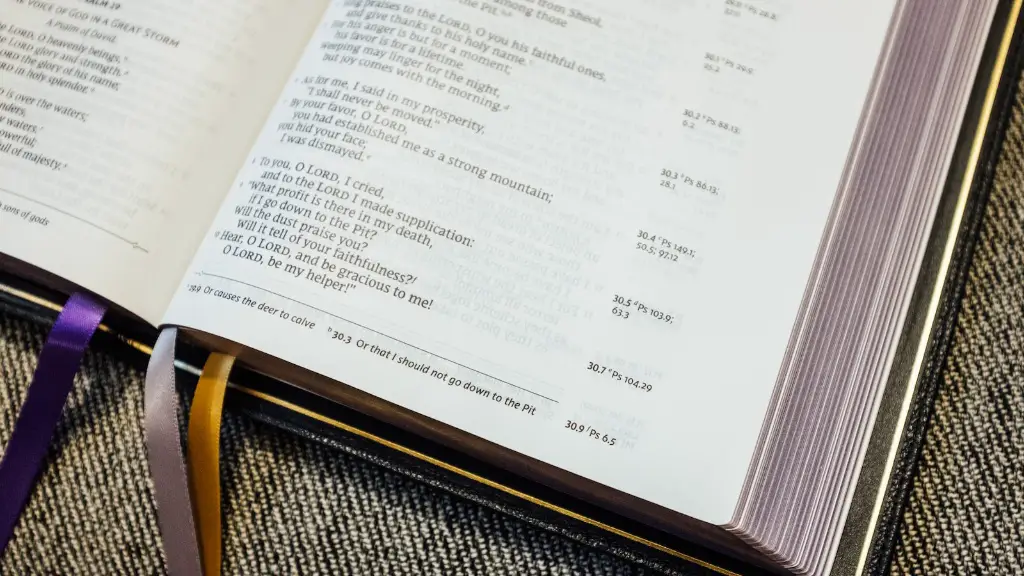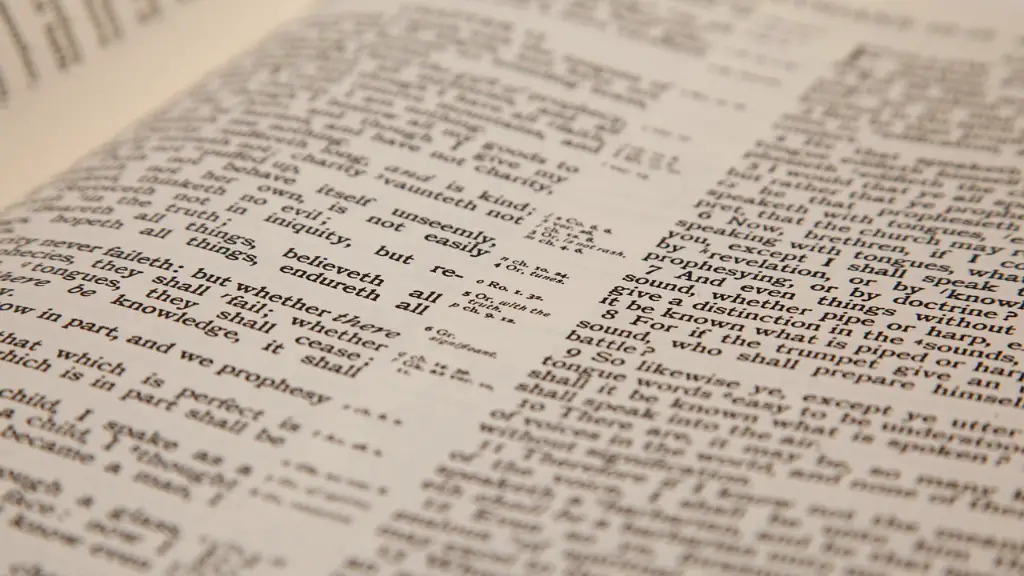The task of translating the Bible into many languages is a complex, centuries-old endeavour that still continues today. The Bible has been translated into more than 2,000 languages from its original Hebrew, Greek, and Aramaic. Its translation has played an important role in uniting people around the world and continues to create relationships and inspire faith among many cultures.
The process of the Bible’s translation began centuries ago, when ancient translations of the Hebrew and Greek texts were first made into Latin. This version became known as the Vulgate, meaning “common version”, and was the only Bible available to the western world until the mid-1500s. In the ensuing years, the Bible was translated into multiple languages and eventually became available in many more languages.
The task of translating the Bible is often difficult due to the complexity of the ancient languages it was originally written in. Translators have to contend with ambiguities, ambiguities, and cultural differences that can be difficult to interpret. The translators must also maintain the original meaning and sacred nature of the text without any distortion. To this end, different methods and techniques have been developed over time to ensure an accurate translation.
One method is the use of dynamic equivalence. This method attempts to closely match the meaning and intent of the source text with the translation. Another method is formal equivalence, which attempts to preserve the original form of the source text as much as possible. Each method has its advantages and disadvantages, depending on the particular circumstances of the translation.
In addition to the challenge of language, the translation of the Bible has also been complicated by its changing landscape over the centuries. With the advent of new technologies and more accessible printing presses, the Bible has had to be continually revised and updated to keep up with the changing times. This has led to many different versions of the Bible in circulation today.
Today, the task of translating the Bible is being continued by many organizations and teams of translators around the world. Bible-translation projects are taking place in virtually every language in the world, with the goal of making the Bible accessible to as many people as possible. Organizations such as Wycliffe Bible Translators and the United Bible Societies are helping to make this goal a reality.
The Bible is one of the most important books in the world and its translation into many languages has served to spread its message to countless people. The continued efforts by translators today insure that its message will continue to reach people living in all corners of the globe.
The Benefits of Bible Translation
Translating the Bible has many benefits, innate to its ability to reach more people and cultures. Its text can offer solace, guidance, and define meaning in areas of one’s life that can feel chaotic and difficult to manage. When the Bible is translated into a language, previously inaccessible, its familiar text can create a sense of security and reassurance that a person may need in their most trying times.
In addition to its spiritual benefits, translating the Bible has real, tangible effects on communities. By having access to the ancient text, language-speaking communities can identify and find resources that might have been inaccessible before. This can include medical, educational, and even economic resources that can lead to economic growth and development for those speaking the newly translated language.
The Bible can also strengthen social connections and relationships within cultures, by providing a text to unite people of different backgrounds, values, and ideologies. Establishing a common text, regardless of language, has the potential to create understanding among different cultures, a quality that can strengthen relationships, both personal and professional.
The Challenges of Bible Translation
Despite the many benefits of translating the Bible, there are also several challenges that arise when engaging in such a task. One of the greatest of these is trying to capture the original meaning and spirit of the text without any distortion or error. Translating ancient texts can also be challenging due to their ambiguity, requiring for the translator to have a nuanced and deep understanding of the source language.
Additionally, translating the Bible can be a lengthy and expensive process. As the times have changed, so have the technologies and resources available to translators. While this can be beneficial in that it makes translating more accessible, it also spurs on more costs and hours that need to be dedicated to the process.
The task of translating the Bible has also sparked controversy in many places, with some arguing that it should not be altered, while others insist that it should be translated in order to make it available to more people. This debate has caused debates over texting, phrasing, syntax, and other elements of the translation process.
Models of Bible Translation
When translating the Bible, there are several models that translators can follow. One of these is the literal approach, in which the translator attempts to adhere as closely to the original source text as possible. Another model is the dynamic equivalence approach, in which the translator attempts to convey the same meaning and intent of the source text into the target language.
A third approach is the free translation approach, which is much less structured and allows for the translator to include their own opinion and interpretation of the source text. This approach has many detractors, however, as it can potentially lead to incorrect translations. It is still used in certain cases, when intended for an audience with limited knowledge of the source language.
Finally, a fourth model is the functional equivalence approach, in which the translator seeks to convey the same feeling and emotion of the source text through their own words. This approach is used to make the text more engaging and accessible to the reader and can be tailored to a specific audience.
Modern Approaches to Bible Translation
In modern days, the process of translating the Bible has been made easier thanks to advances in technology. Translators are no longer limited to traditional methods of translation, but also have access to software and computer programs that can aid in their process. As a result, the rate of Bible translations have noticeably accelerated in recent years.
In addition, organizations have emerged that focus on Bible translations and offer assistance in bringing the texts to people who do not have access to them. These efforts include the provision of resources, training, and advice to translators in order to ensure accurate and effective translations.
Furthermore, recent advances in printing have enabled for quicker and simpler access to the Bible. Organizations such as Bible League International and Ligonier Connect have created various initiatives to make the texts of the Bible available in as many languages as possible. These initiatives are often aided by generous donations, allowing for more translations to take place.
Implications of Bible Translation
The act of translating the Bible carries with it several implications. One of these is the ability to bring the text to new people and cultures who would not have been able to access it before. Additionally, establishing a text that is the same across different communities can help to create understanding between them and foster stronger relationships.
On a grander scale, the task of translating the Bible has the potential to unite people from all walks of life and encourage peace. Although, admittedly, it cannot solve all of the world’s problems, its ability to transcend language barriers, create relationships, and unite people together stands firmly as one of its most profound implications.
Conclusion
Bible translations have played an important role in spreading its message and providing solace and support to many people and cultures across the world. Its continued translation today not only provides access to the sacred text, but also acts as an important connector between cultures and communities. Its implications, both tangible and intangible, cannot be understated and will continue to be felt by many in the years to come.





